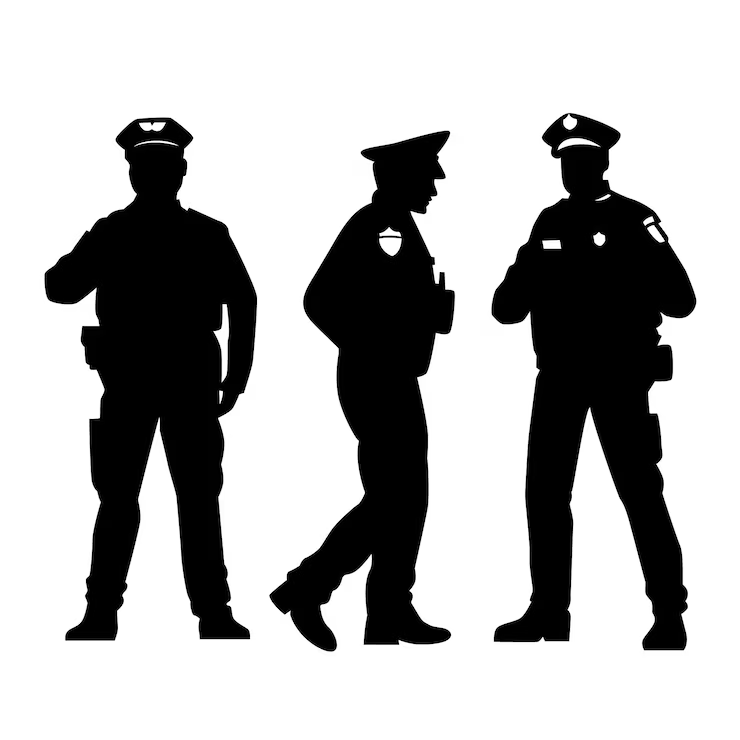TABLE OF CONTENT
ToggleMachinery of Law and Order In District-I
Hey Mumbai University SYBA IDOL students! Today, we’re diving into the fascinating world of Rural Administration , exploring about – “Machinery of Law and Order In District-I“.
We’ll start by exploring the various features of police administration. This will help us understand how the police system is organized and the key elements that make it effective in maintaining law and order.
Next, we’ll define Law and Order and explain the role of the District Superintendent of Police. We’ll discuss what “Law and Order” means and how the District Superintendent of Police is crucial in managing and enforcing laws to ensure safety and security in the district.
Finally, we’ll take a detailed look at the Police Patil. This role is important in rural areas, and we’ll cover what responsibilities and duties a Police Patil has in assisting with local law enforcement.
So, SYBA IDOL Mumbai University students, get ready to unwrap the mysteries of “Machinery of Law and Order In District-I” with customized IDOL notes just for you. Let’s jump into this exploration together


QUESTIONS AND ANSWERS:-
Question 1 :- Write the various features of police administration
Introduction:
Police administration plays a crucial role in maintaining law and order, protecting citizens, and ensuring justice. It operates within a framework established by law and follows a structured hierarchy. This answer will discuss the key features of police administration, highlighting its legal basis, structure, responsibilities, and focus on personnel welfare. Understanding these features provides insight into how the police function and contribute to societal safety and order.
- Creation and Regulation by Law: Police administration is built upon legal foundations that guide its operations.
- Legal Framework: The police system is established under laws like The Indian Police Act of 1861 and the Mumbai Police Act of 1951. These laws provide the legal basis for the functioning of the police and outline their duties and powers.
- Hierarchy and Structure: The police force is organized in a hierarchical structure.
- Rank System: The police force has a clear hierarchy, starting from the Director-General of Police (DGP) at the top, down to various ranks like Inspectors, Sub-Inspectors, and Constables. This structure helps in effective command and control, ensuring organized management.
- Responsibilities: The police have several important duties.
- Maintaining Law and Order: The main job of the police is to keep peace and order in society. They protect people’s lives and property, prevent crime, and enforce laws.
- Crime Investigation: Police are responsible for investigating crimes and bringing offenders to justice, ensuring that the law is upheld.
- Training and Recruitment: Training is essential for the effectiveness of the police force.
- Recruitment: New police officers are recruited based on specific criteria to ensure they are fit for the job.
- Ongoing Training: Police officers receive continuous training to improve their skills and stay updated on new methods and technologies.
- Discipline and Efficiency: Discipline and efficiency are vital for a well-functioning police force.
- Maintaining Discipline: The police force conducts regular drills, tests, and other activities to ensure discipline.
- Awards and Promotions: Outstanding performance is recognized through awards and promotions, motivating officers to perform well.
- Public Relations: Building good relationships with the community is crucial for effective policing.
- Community Engagement: Police work to build trust with the public by being transparent and engaging with community members.
- Trust and Cooperation: Strong public relations help in gaining community cooperation, which is essential for effective law enforcement.
- Compliance with Orders: Adherence to orders and directives ensures lawful operation.
- Following Orders: Police officers must follow court orders and directives from higher officials. This ensures that their actions are legally justified and consistent with higher authority.
- Welfare of Personnel: The welfare of police personnel is an important aspect of police administration.
- Health and Education: The administration provides healthcare and educational facilities for the families of police personnel.
- Recognition: The contributions of police officers are acknowledged through various awards, enhancing their morale and job satisfaction.
Conclusion:
The features of police administration reflect a well-organized system designed to maintain law and order, protect citizens, and ensure justice. From its legal foundation and structured hierarchy to its focus on training, discipline, public relations, and personnel welfare, each aspect plays a critical role in the effectiveness of the police force. By understanding these features, we gain a clearer picture of how the police contribute to a safe and orderly society.
Question 2 :- Explain the meaning of Law and Order. Explain the role of District Superintendent of Police in law and order
Introduction:
Law and Order is crucial for maintaining peace and safety in society. It involves creating and enforcing laws to protect individuals and ensure that society functions smoothly. The role of the District Superintendent of Police (SP) is vital in maintaining law and order within a district. This answer will explain the meaning of Law and Order and the important responsibilities of the District Superintendent of Police.
A. Meaning of Law and Order: Law and Order are essential for a safe and functioning society.
- Definition: Law and Order means having rules (laws) and making sure these rules are followed to keep society safe and orderly.
- Complementarity: Law and order work together to protect people’s rights and keep the peace in society.
- Protection: The main goal is to keep people and their property safe from harm.
- Civil Power: Civil authorities, like the police, should handle law and order, rather than using military force.
- Rule of Law: Laws should be applied fairly and equally to everyone, without favoritism.
- Use of Force: The police can use force, but it must be necessary and controlled to maintain order.
B. Role of District Superintendent of Police (SP) in Law and Order: The District Superintendent of Police (SP) has key responsibilities in maintaining law and order.
- Leadership and Management:
- Role: The SP is in charge of the police in the district. They manage police operations and resources.
- Responsibility: Ensures the police force runs smoothly and effectively.
- Crime Prevention and Control:
- Role: The SP works to reduce crime by creating strategies to prevent illegal activities.
- Responsibility: Protects very important persons (VIPs) and ensures their safety.
- Training and Discipline:
- Role: The SP organizes training for police officers to keep them skilled and motivated.
- Responsibility: Maintains discipline among officers, conducts tests, and rewards good performance.
- Compliance with Legal Orders:
- Role: Ensures that police actions follow court orders and higher authority instructions.
- Responsibility: Keeps the law enforcement process fair and lawful.
- Public Relations:
- Role: The SP builds good relationships with the community to gain their trust.
- Responsibility: Works to improve public confidence in the police through openness and community interaction.
- Reporting and Accountability:
- Role: Attends meetings with senior officials and reports on police activities in the district.
- Responsibility: Reviews police work and addresses any issues with subordinate officers.
- Welfare Initiatives:
- Role: Focuses on the well-being of police personnel.
- Responsibility: Provides support systems, healthcare, and educational opportunities for their families.
Conclusion:
Law and Order are essential for maintaining peace and safety in society through fair and consistent rule enforcement. The District Superintendent of Police (SP) plays a key role in upholding this order by leading the police force, preventing and controlling crime, ensuring compliance with laws, and fostering positive community relationships. The SP’s responsibilities extend to managing police operations, maintaining discipline, and supporting both the community and police personnel. Understanding these roles highlights the importance of effective law enforcement in creating a safe and orderly society.
Question 3 :- Write detail note on Police Patil
Introduction:
The role of Police Patil is an important part of the policing system in rural areas of Maharashtra, India. Established initially during the British era and reintroduced in 1967, Police Patils serve as a crucial link between the police and the community. This answer will provide a detailed explanation of the Police Patil role, including their history, eligibility criteria, responsibilities, and significance.
- Definition and Historical Context: The role of Police Patil was created to improve local policing in villages.
Historical Background:
- British Era: The position of Police Patil was first introduced under the Mumbai Civil Act of 1857.
- Abolition and Reintroduction: Although abolished in 1946, the role was reinstated in 1967 under the Maharashtra Gram Police Act to enhance local policing in rural areas.
Role:
- Link Between Police and Community: Police Patils act as a vital connection between the police and villagers, ensuring effective communication and cooperation.
- Eligibility Criteria: Candidates must meet specific requirements to become a Police Patil.
Requirements:
- Residency: Must be a resident of the village where they seek appointment.
- Age: Candidates should be between 25 to 45 years old.
- Physical Competence: Must be physically fit to perform their duties.
- Behavior: A good moral character is essential.
- Educational Qualification: Must have completed at least the 10th grade.
- Priority for Backward Classes: Preference is given to candidates from backward classes.
- Employment Restrictions: Cannot hold any other job or accept any other post during their tenure.
- Appointment and Control: The appointment and supervision of Police Patils are handled by various authorities.
Appointment:
- Authority: Appointed by the Deputy Collector or Divisional Officer.
- Tenure: Initial appointment is for five years, with the possibility of extension up to the age of sixty.
Supervision:
- Local Officials: Supervised by the Talathi, Tehsildar, and the concerned police station.
- Roles and Responsibilities: Police Patils have several important duties in their villages.
Key Responsibilities:
- Crime Reporting: Report crimes to the police and assist in investigations.
- Community Liaison: Act as a bridge between the police and villagers, helping build trust and cooperation.
- Maintaining Peace: Monitor local activities, address issues before they escalate, and help maintain peace and order.
- Public Awareness: Provide information about laws, regulations, and safety measures to villagers.
- Support in Emergencies: Assist the police in managing emergencies and ensuring public safety.
- Leave and Honorarium: Police Patils receive certain benefits and allowances for their service.
Leave:
- Authority: The Tehsildar grants leave to Police Patils.
Honorarium:
- Amount: The state government sets the honorarium, currently ₹1200 per month.
- Education Benefit: Children of Police Patils who meet certain conditions are entitled to free education.
- Significance: The role of Police Patil is crucial in rural policing.
Importance:
- Localized Support: Provides support to the police force at the village level.
- Community Engagement: Enhances community involvement and cooperation with law enforcement.
- Safety and Security: Contributes to the overall safety and security of the village, fostering a sense of security among villagers.
Conclusion:
Police Patils play a significant role in rural policing by serving as a link between the police and the community. Their responsibilities include reporting crimes, maintaining peace, and assisting in emergencies. With specific eligibility criteria, appointment procedures, and benefits, Police Patils are crucial in ensuring effective law enforcement and fostering cooperation within rural areas. Their presence strengthens community-police relations and enhances overall village safety.
MCQs:-
i) The post of Police Patil came up in period.
A. Post-Independence,
B. Mughal,
C. British
D. Portuguese
ANS- British
ii) The first lok-Adalat held in —state.
A. Maharashtra
B. Bihar,
C. Gujarat,
D. Delhi.
ANS- Gujarat
iii) Legal Services Authorities Act, 1987 gave a statutory status to
A. LokAdalats.
B. Public Administration.
C. Loksabha
D. VidhanParishad.
ANS-LokAdalats
Important Note for Students :– Hey everyone! All the questions in this chapter are super important!
